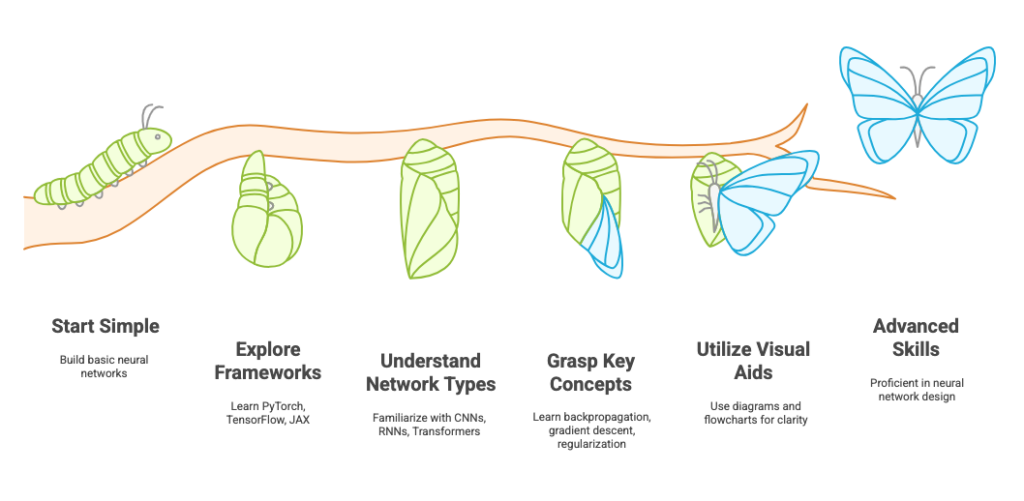Learning AI step by step is more than mastering algorithms; it’s about embracing a transformative journey into a world of innovation and endless possibilities. Whether you’re new to artificial intelligence or refining your skills, this guide provides a clear, practical pathway to mastering AI essentials. Explore foundational programming, neural networks, real-world projects, and the evolving landscape of AI with actionable insights to navigate this exciting field effectively
Step 1: Master the Basics with Python
Learning AI starts with understanding its foundational tools, and Python is the go-to programming language. Here’s how to get started:
Key Recommendations:
- Learn Python First: Start with courses like “Python for Everybody” by Dr. Charles Severance, available for free on platforms like Coursera.
- Explore Python Libraries: Familiarize yourself with essential libraries such as NumPy (for numerical computing), pandas (for data manipulation), and matplotlib (for data visualization).
- Leverage Tutorials: Use AI-focused Python tutorials from reputable sources like Real Python or freeCodeCamp.
- Topical Books: Opt for books like Deep Learning by Ian Goodfellow or Python for Data Analysis by Wes McKinney to focus on AI-related applications.
- Rule of Two: Read two books on the same topic from different authors for a balanced perspective.
Mathematical Prerequisites:
A solid foundation in mathematics is crucial for understanding AI algorithms. Focus on the following areas:
- Linear Algebra: Essential for understanding concepts like matrices, vectors, and tensor operations used in neural networks.
- Calculus: Critical for grasping optimization techniques such as gradient descent.
- Statistics: Important for working with probability distributions and data analysis.
The goal is to gain a working knowledge of Python and the underlying mathematics, applying the 80/20 rule to maximize learning efficiency.
Step 2: Undertake Practical Projects
Once you have the basics down, transition to building projects. Practical experience is invaluable for solidifying your knowledge.
Project Ideas:
- Align Projects with Interests: Whether it’s home automation, stock market modeling, or Raspberry Pi projects, choose topics you’re passionate about.
- Emerging Trends for 2025: Explore projects like:
- AI for personalized medicine, predicting patient outcomes or optimizing care pathways.
- AI for environmental sustainability, such as analyzing climate data or optimizing renewable energy systems.
- AI-powered IoT for home automation or edge computing.
- Building generative models for text, images, or creative content.
- Expect Setbacks: Embrace failures as learning opportunities. Projects should challenge you but remain manageable.
- Measure Outcomes: Aim for projects with tangible results, like automating tasks or developing predictive models.
Personal projects not only reinforce learning but also help you build a portfolio showcasing your skills.
Step 3: Build a Deep Neural Network
Understanding how neural networks work is a critical milestone in learning AI.
Approach:
- Start Simple: Use frameworks like PyTorch, TensorFlow, or JAX to build a basic neural network. Each framework has unique advantages:
- PyTorch: Known for its flexibility and dynamic computation graph, it’s widely used in research and industry.
- TensorFlow: Offers robust support for production-grade deployments and mobile/edge computing.
- JAX: Optimized for high-performance numerical computing and widely adopted in cutting-edge research.
- Explore Neural Network Types: Gain familiarity with different types of networks and their use cases:
- Convolutional Neural Networks (CNNs): Best for image-related tasks like object detection or image classification.
- Recurrent Neural Networks (RNNs): Ideal for sequential data, such as time series or natural language processing.
- Transformer Models: Crucial for language-related tasks, especially with large language models like GPT and BERT. Transformers also power generative AI applications, such as text and code generation, or creative content creation.
- Key Concepts: Understand fundamental principles such as:
- Backpropagation: The mechanism by which networks learn by adjusting weights.
- Gradient Descent: A method to minimize the loss function by iteratively updating weights.
- Regularization: Techniques like dropout to prevent overfitting and improve generalization.
- Visual Aids: Use diagrams to visualize network architectures and flowcharts to represent data pipelines for better comprehension.

Practical MLOps:
- Introduce the concept of MLOps (Machine Learning Operations):
- Covers the lifecycle of machine learning models from development to deployment and monitoring.
- Use tools like MLflow or Kubeflow for tracking experiments and automating workflows.
- Deployment: Practice deploying models using cloud platforms like AWS SageMaker, Google Cloud AI, or Azure Machine Learning.
Building and tweaking neural networks not only enhances technical understanding but also equips you with practical skills for solving diverse AI problems.
Step 4: Join Competitions
Competitions can accelerate your learning by exposing you to real-world problems and messy datasets.
Why Competitions Matter:
- Real-World Challenges: Competitions simulate real-world scenarios where goals aren’t always clear.
- Beginner-Friendly Platforms: Start with Kaggle’s beginner-friendly competitions, such as Titanic: Machine Learning from Disaster or the House Prices prediction challenge. Explore other platforms like DrivenData or Zindi, which focus on competitions with social impact. Platforms like AIcrowd also offer challenges in cutting-edge areas like robotics and reinforcement learning.
- Collaborative Learning: Join teams on Kaggle or similar platforms to learn from others while working on complex problems.
- Focus on Growth: Winning isn’t the point—growth and learning are the primary objectives. Competitions push you to develop new skills, clean messy data, and optimize models for better performance.
Step 5: Master Language and Creativity
AI is heavily tied to language, both in programming and in understanding human communication.
Key Focus Areas:
- Study Language: Dive into linguistics and large language models to understand the intersection of AI and human communication. Use tools like Hugging Face Transformers to experiment with state-of-the-art NLP models.
- Cross-Train Your Brain: Engage in creative activities like writing or art to develop innovative problem-solving skills. Collaborate on interdisciplinary projects blending AI with design or music.
- Read Extensively: Books are a powerful resource for expanding your understanding of AI and its applications. Include fiction and technical texts to balance creativity with technical expertise.
Developing creativity and a strong grasp of language can enhance your ability to innovate and apply AI in diverse contexts.
Step 6: Align with Your Purpose
AI is more than a skill set; it’s a field that thrives on passion and purpose.
Discover Your Purpose:
- Find Your Passion: Identify what excites you most, even if it feels daunting.
- Align Your Efforts: Pursue projects and goals that resonate with your higher purpose.
- Embrace the Journey: Focus on learning and experimentation without worrying about immediate rewards.
- Explore Career Paths: Consider roles such as:
- Data Scientist: Focused on analyzing and interpreting complex data to provide actionable insights.
- Machine Learning Engineer: Builds and optimizes machine learning models for various applications.
- AI Researcher: Advances the field by developing new algorithms and exploring theoretical concepts.
- AI Product Manager: Bridges the gap between technical teams and business objectives, ensuring AI solutions align with organizational goals.
Purpose-driven learning fosters resilience and long-term growth, making your AI journey more fulfilling.
Conclusion
Learning AI is a journey filled with challenges and opportunities. By mastering the basics, undertaking practical projects, building neural networks, participating in competitions, and aligning with your purpose, you can unlock AI’s transformative potential. To maintain momentum in this rapidly evolving field, it’s essential to prioritize continuous learning. Stay updated with the latest research papers, attend AI conferences like NeurIPS or ICLR, and actively participate in online communities like GitHub and Reddit to remain informed and connected.
Ethical considerations are also paramount. As AI becomes more pervasive, understanding and addressing issues like bias, fairness, and responsible development are integral to its application. Building AI systems that align with ethical standards ensures long-term trust and sustainability.
Remember, the key is not just to learn but to enjoy the process and stay committed to your goals. This is the way forward.





Leave a Reply